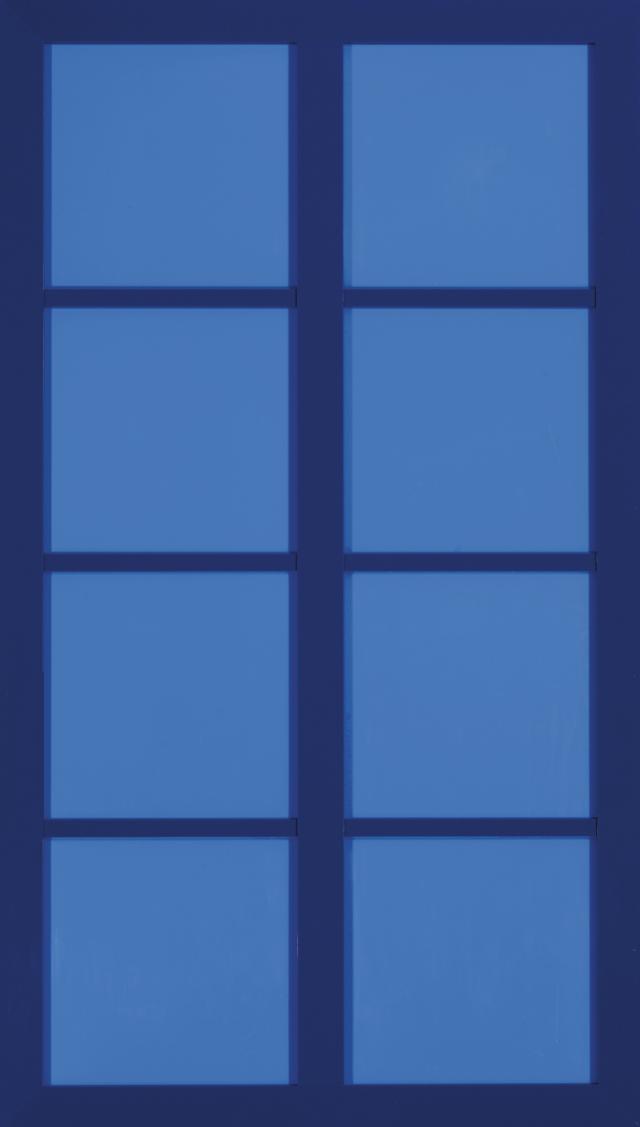Sealed, opaque, fashioned from acrylic glass and its mirrored reflections, the French windows that Ugo Rondinone has devised for us offer a work of art whose motif provokes mystery even though it springs from utter banality. What indeed is this opening which denies us access hiding ? These multi-paned win-dows, simple serious forms, are brought to life with colours and plays of texture in a dialectics of opacity and transparency.
Yet something obsessive and troubling is playing out before this series of shutup windows. The gaze cannot pass through the shiny surface. It bounces off the impenetrable panes whose reflection reveals, not an unknown outside horizon, but rather the world around the piece. The eye glances off them and is turned back on itself and its surroundings.
It is not only the question of visibility that is raised here ; these works likewise summon significant moments in the history of art. Citing Marcel Duchamp and his Fresh Widow (1920-1964), a ready-made featuring a miniature version of a French window, Rondinone is also reacting sculpturally and mischievously to the assertion by the famous fifteenth-century Italian hu-manist and art theoretician Leon Battista Alberti when he compares painting to a window that is open on the outside world. Rondinone’s windows, indifferently closed, refute and contradict that interpretation, offering in place of the promise of an elsewhere a reflection of the same.
The artist’s works always come with a title that is carefully chosen, often inspired by literature, music or poetry, and written according to typographic rules laid down by the artist. The title of this series of windows refers to the haunting poems of Franz Wright, texts that are pervaded with grace and dread.
Poetry and Romanticism are there as well, with the painter Philipp Otto Runge, whose project involving four paintings on the Times of the Day finds a contemporary echo in the suggestion of crucial moments of the day represented by the four windows.
But despite the leads and quotations that Rondinone scatters around his work, a veil persists. As the artist him-self underscores, “It’s a monologue. It’s not something that has to be translated for the viewer as well. It gives me a guideline. The viewer has the symbols from which they can create their own story, but it’s not required that you decode my motivation. It’s a bit like Duchamp. He had his own monologue. He left it always open, so people just made up a bunch of speculations about his work.”
Yet something obsessive and troubling is playing out before this series of shutup windows. The gaze cannot pass through the shiny surface. It bounces off the impenetrable panes whose reflection reveals, not an unknown outside horizon, but rather the world around the piece. The eye glances off them and is turned back on itself and its surroundings.
It is not only the question of visibility that is raised here ; these works likewise summon significant moments in the history of art. Citing Marcel Duchamp and his Fresh Widow (1920-1964), a ready-made featuring a miniature version of a French window, Rondinone is also reacting sculpturally and mischievously to the assertion by the famous fifteenth-century Italian hu-manist and art theoretician Leon Battista Alberti when he compares painting to a window that is open on the outside world. Rondinone’s windows, indifferently closed, refute and contradict that interpretation, offering in place of the promise of an elsewhere a reflection of the same.
The artist’s works always come with a title that is carefully chosen, often inspired by literature, music or poetry, and written according to typographic rules laid down by the artist. The title of this series of windows refers to the haunting poems of Franz Wright, texts that are pervaded with grace and dread.
Poetry and Romanticism are there as well, with the painter Philipp Otto Runge, whose project involving four paintings on the Times of the Day finds a contemporary echo in the suggestion of crucial moments of the day represented by the four windows.
But despite the leads and quotations that Rondinone scatters around his work, a veil persists. As the artist him-self underscores, “It’s a monologue. It’s not something that has to be translated for the viewer as well. It gives me a guideline. The viewer has the symbols from which they can create their own story, but it’s not required that you decode my motivation. It’s a bit like Duchamp. He had his own monologue. He left it always open, so people just made up a bunch of speculations about his work.”
